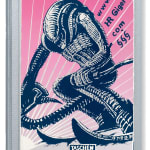H.R. Giger
wwwHRGigercom, 1994
Hardcover in clamshell box, 23.8 x 29.7 cm, 2.46 kg, 240 pages
Edition of 277
Book numbered and signed by H.R. Giger
Foldable poster numbered and signed by H.R. GIger
Foldable poster numbered and signed by H.R. GIger
Copyright The Artist
Photo: TASCHEN
Further images
-
(View a larger image of thumbnail 1
)

-
(View a larger image of thumbnail 2
)

-
(View a larger image of thumbnail 3
)

-
(View a larger image of thumbnail 4
)

-
(View a larger image of thumbnail 5
)

-
(View a larger image of thumbnail 6
)

-
(View a larger image of thumbnail 7
)

-
(View a larger image of thumbnail 8
)

-
(View a larger image of thumbnail 9
)

-
(View a larger image of thumbnail 10
)

-
(View a larger image of thumbnail 11
)

-
(View a larger image of thumbnail 12
)

This limited edition was designed by the artist himself, and features detailed commentaries in which Giger describes his work from the early 1960s to the late ’90s. Limited Art Edition...
This limited edition was designed by the artist himself, and features detailed commentaries in which Giger describes his work from the early 1960s to the late ’90s.
Limited Art Edition of 277 copies worldwide (120 copies in German)
Includes a numbered and signed fold-out print (63.7 x 83.7 cm / 25 x 33 in.)
“I paint what frightens me.”— HR Giger
The artist: HR Giger (1940–2014) was a Swiss painter, sculptor, and designer, who combined surrealist influences and dark fantasies to create his very own biomechanical universe. He first received acclaim in the 1960s with his airbrushed fantasies of post-apocalyptic creatures and landscapes, and rose to fame through high profile movie work, most notably the creation of the monster in Alien, which won the Academy Award for Best Visual Effects.
Limited Art Edition of 277 copies worldwide (120 copies in German)
Includes a numbered and signed fold-out print (63.7 x 83.7 cm / 25 x 33 in.)
“I paint what frightens me.”— HR Giger
The artist: HR Giger (1940–2014) was a Swiss painter, sculptor, and designer, who combined surrealist influences and dark fantasies to create his very own biomechanical universe. He first received acclaim in the 1960s with his airbrushed fantasies of post-apocalyptic creatures and landscapes, and rose to fame through high profile movie work, most notably the creation of the monster in Alien, which won the Academy Award for Best Visual Effects.












